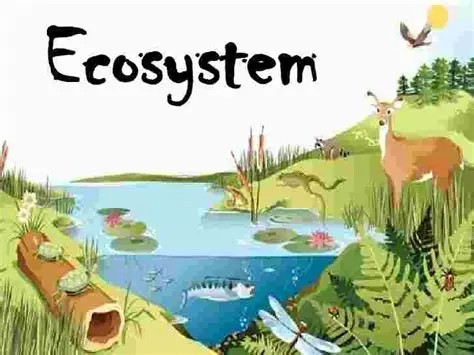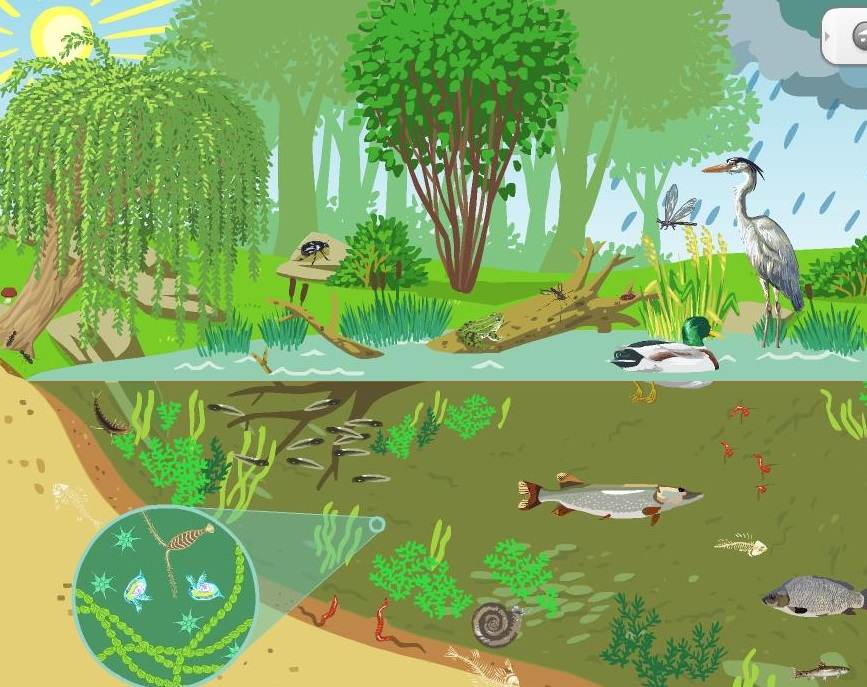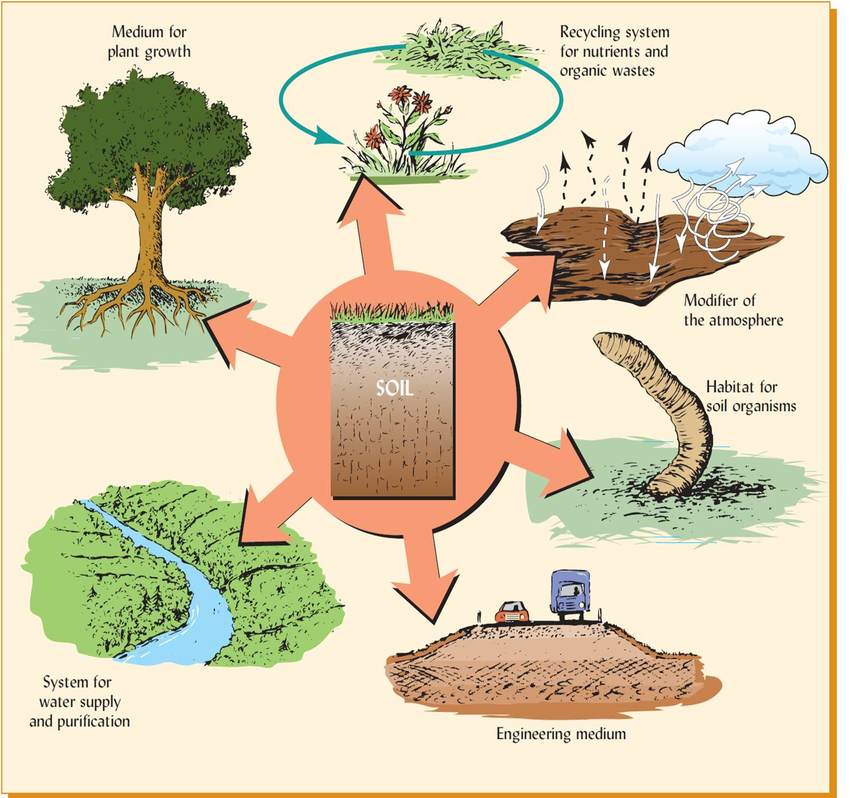Introduction
Nature is a complex and interconnected web of living organisms and their physical surroundings. Everything in nature interacts in some way animals eat plants, plants need sunlight, fungi break down dead materials, rivers bring water, and the sun provides energy. All these relationships form what we call an ecosystem. It is one of the most fundamental concepts in ecology and environmental science.

An ecosystem is not just a forest or a lake; it can be as large as an ocean or as small as a drop of pond water. Every ecosystem is unique, yet they all share a similar structure and function. In this document, we will explore the complete idea of environment their definition, structure, the factors that influence them, their types, and the roles they play in the Earth’s life-support system.
Table of Contents
Definition
It is a community of living organisms (biotic factors) interacting with non-living components (abiotic factors) of their environment, working together as a system. It includes all the organisms in a given area and the physical environment they interact with.

In simple terms, it is a self-sustaining unit of nature where life and the environment are closely linked. It involves the flow of energy and cycling of nutrients.
Examples
- A forest with trees, animals, fungi, soil, and water
- A pond with fish, algae, insects, and sunlight
- A coral reef with fish, corals, seawater, and light
- A desert with cacti, lizards, sand, and dry air
Structure
Its structure can be divided into two main components:

1. Biotic Components (Living)
These are the living organisms in an environment and can be further categorized into:
a. Producers (Autotrophs)
- They make their own food using sunlight or chemicals.
- Example: Green plants, algae, phytoplankton
b. Consumers (Heterotrophs)
- They depend on other organisms for food.
- Types:
- Primary consumers (herbivores): Deer, rabbits
- Secondary consumers (carnivores): Frogs, foxes
- Tertiary consumers (top predators): Lions, eagles
c. Decomposers (Saprotrophs)
- Break down dead organisms and recycle nutrients.
- Example: Bacteria, fungi, earthworms
d. Detritivores
- Feed on decaying organic matter.
- Example: Millipedes, dung beetles
2. Abiotic Components (Non-living)
These are the physical and chemical factors that affect living organisms:
- Sunlight
- Temperature
- Water availability
- Soil type
- Air and gases
- Minerals and nutrients
These components determine what kind of life can exist in an environment.
Factors Influencing Ecosystems
It is dynamic and influenced by a wide range of factors. These can be grouped into biotic and abiotic factors.
A. Abiotic Factors
1. Sunlight
- Primary source of energy
- Affects photosynthesis and temperature
2. Temperature
Influences metabolic rates and organism survival
3. Water
- Essential for all life
- Influences plant growth and animal distribution
4. Soil
Determines types of plants and nutrient availability
5. Climate
Long-term weather patterns shape ecosystems
B. Biotic Factors
1. Species Interactions
Predation, competition, mutualism
2. Population Dynamics
Changes in population size and composition
3. Human Activities
Deforestation, pollution, agriculture, urbanization
Types
It can be classified based on habitat type or origin:
A. Natural Ecosystems
These form naturally without human influence.
1. Terrestrial Ecosystems
- Found on land
- Examples: Forests, deserts, grasslands, tundra
2. Aquatic Ecosystems
- Found in water bodies
- Examples:
B. Artificial Ecosystems
These are man-made systems created for specific purposes.
Examples:
- Agricultural fields
- Aquariums
- Urban parks
- Zoos and botanical gardens
C. Micro-ecosystems
Very small ecosystems with limited scale.
Examples:
- A tree hole filled with rainwater
- A puddle
- A decaying log
Functions
It performs essential functions that support life on Earth. These can be categorized into:
1. Energy Flow
- Energy enters an ecosystem through sunlight.
- Producers convert light into chemical energy via photosynthesis.
- This energy flows through trophic levels (producers → consumers → decomposers).
- Energy decreases at each level due to heat loss (10% rule).
2. Nutrient Cycling
- Nutrients like carbon, nitrogen, phosphorus are recycled.
- Decomposers break down dead material and release nutrients.
- Essential for plant growth and ecosystem stability.
3. Regulation of Climate and Atmosphere
- Forests regulate CO2 and oxygen balance.
- Oceans absorb carbon and control temperature.
4. Water Purification and Soil Formation
- Wetlands filter pollutants
- Decomposers help form fertile soil
5. Pollination and Seed Dispersal
Insects, birds, and wind help plants reproduce
6. Biodiversity Maintenance
- A healthy environment supports diverse species
- High biodiversity ensures ecosystem resilience
7. Support for Human Life
- Provides food, medicine, raw materials
- Offers recreational and cultural value
Human Impact
Human activities have significantly altered natural ecosystems:
- Deforestation leads to habitat loss
- Pollution affects air, water, and soil
- Climate change alters temperature and rainfall
- Urbanization disrupts natural balance
- Overfishing and poaching disturb food chains
Restoration and conservation efforts are necessary to maintain environment balance.
Importance
- Life support systems: Provide essentials like air, water, and food
- Balance and stability: Maintain natural cycles
- Economic value: Through agriculture, fisheries, tourism
- Cultural and spiritual value: Sacred groves, natural beauty
- Scientific study: Understand life and ecological processes
Conclusion
Ecosystems are the beating heart of our planet. They are intricate networks where life and environment work in harmony. By understanding it their components, types, and functions we gain insight into the delicate balance of nature.
It provide everything we need to live: clean air, fresh water, fertile soil, food, and even mental peace through their beauty. But they are under threat from our actions. Protecting them is not just a duty; it’s essential for our own survival.
When we conserve environment, we are investing in the future of humanity and all life on Earth. The more we understand how it functions, the better equipped we are to protect them.
Three Key Takeaways
- It is a system of living and non-living components interacting in a defined area.
- It performs vital functions like energy flow, nutrient cycling, and biodiversity maintenance.
- Human activities affect environment balance, but with awareness and conservation, we can restore and protect them.
Frequently Asked Questions (FAQs)
What is the difference between habitat and ecosystem?
A habitat is the physical place where an organism lives.
An ecosystem includes both the habitat and all the interactions between organisms and their environment.
Can ecosystems be artificial?
Yes, ecosystems like crop fields, aquariums, and urban parks are artificial and managed by humans.
Why is biodiversity important in an ecosystem?
High biodiversity increases resilience, productivity, and the ability of ecosystems to recover from disturbances.
Related Articles




